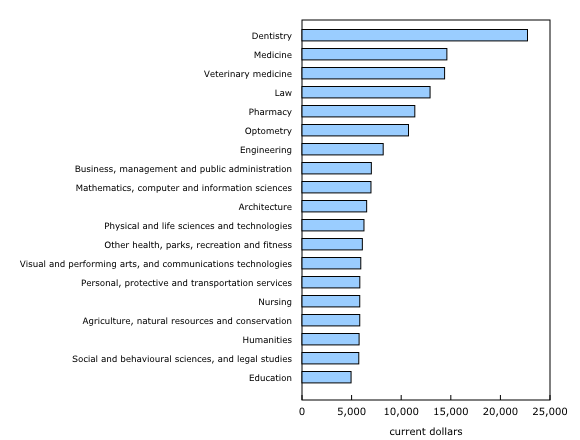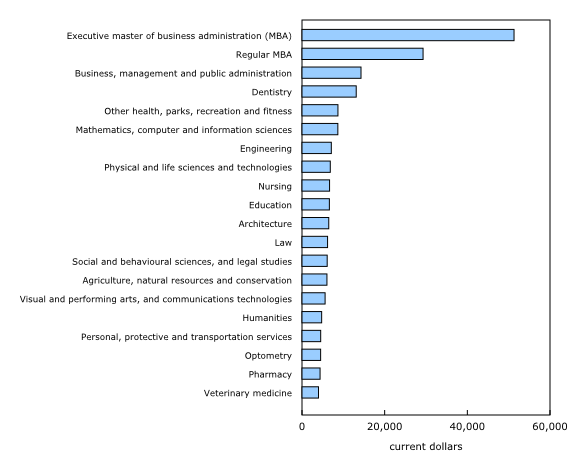Tuition fees for degree programs, 2021/2022
Archived Content
Information identified as archived is provided for reference, research or recordkeeping purposes. It is not subject to the Government of Canada Web Standards and has not been altered or updated since it was archived. Please "contact us" to request a format other than those available.
Released: 2021-09-08
Tuition fees for degree programs increased for both undergraduate and graduate students for the 2021/2022 academic year. While the fall 2021 term will see postsecondary institutions offer a combination of online and in-person instruction in response to the pandemic, students will pay higher tuition fees on average compared with the previous academic year.
Tuition fees increase for Canadian undergraduate and graduate students
Nationally, Canadian students enrolled full-time in undergraduate programs will pay, on average, $6,693 in tuition for the upcoming 2021/2022 academic year, up 1.7% from the previous year. The average cost for graduate programs rose 1.5% to $7,472. These increases are similar to those seen in the fall of 2020/2021. To further explore 2021/2022 tuition fees in a visual format, refer to "Tuition fees for degree programs: Interactive tool."
Average tuition fees reflect both the variety of degree programs offered by institutions and the share of students enrolled in these programs. As a result, even if there are no changes in specific program tuition fees, the average tuition could change if new programs are added or if the distribution of students across programs changes.
While research shows that the earnings premium of having a postsecondary education eventually outweighs the cost of obtaining one, many postsecondary students face financial challenges, which were heightened during the pandemic.
A crowdsourcing initiative in the early months of the pandemic suggested that most students were very concerned about their finances and short-term job prospects, potentially impacting their ability to pay tuition. Recent results from the Labour Force Survey show that the student employment situation improved in the summer of 2021 compared with the previous summer, but it will likely be several years before the longer-term financial impacts of the pandemic on students can be fully understood.
Undergraduate tuition fees were unchanged in Ontario and in Newfoundland and Labrador for the 2021/2022 academic year, but rose in the other eight provinces and in Yukon, with the increases ranging from 1.1% in Prince Edward Island to 7.5% in Alberta. In Alberta, the increase was due to a province-wide restructuring of tuition fees that came into effect the previous year.
Graduate tuition fees for Canadian students were unchanged in Newfoundland and Labrador, but rose in the other nine provinces, ranging from 0.3% in Ontario to 7.4% in Saskatchewan.
The results of the Tuition and Living Accommodation Costs survey do not necessarily reflect the actual cost that students pay for their degree programs. Students may receive financial support, such as scholarships, bursaries, government grants and tax credits, which can vary across institutions and provinces. According to the 2018 National Graduate Survey, over half (56%) of students who graduated with a university degree had received some form of these financial supports.
Undergraduates in a professional degree program pay the highest average tuition fees
Canadian undergraduate students in six professional degree programs paid the highest average tuition fees in 2021/2022: dentistry ($22,731), medicine ($14,604), veterinary medicine ($14,374), law ($12,910), pharmacy ($11,373) and optometry ($10,735).
Based on data from the Postsecondary Students Information System, these six programs account for, on average, 3.7% of all Canadian undergraduate student enrolments each year. Findings from the Education and Labour Market Longitudinal Platform show that graduates of these programs have the highest median employment income two years after graduating.
Four fields of study consistently account for almost three-fifths of undergraduate student enrolments: social and behavioural sciences and legal studies; business, management and public administration; physical and life sciences and technologies; and the humanities.
Full-time Canadian students in social and behavioural sciences and legal studies paid on average $5,725 in 2021/2022, with fees ranging from $2,658 in Newfoundland and Labrador to $7,934 in Nova Scotia.
Undergraduate tuition fees in business, management and public administration were on average $6,991. Students in Newfoundland and Labrador ($2,695) paid the lowest fees, while those in Ontario ($9,406) paid the highest.
In physical and life sciences and technologies, undergraduate students in Newfoundland and Labrador ($2,666) paid the lowest tuition fees, while those in Prince Edward Island, Nova Scotia, New Brunswick, Ontario and Saskatchewan paid more than the Canadian average of $6,246.
Undergraduate tuition fees in the humanities averaged $5,754 in 2021/2022, ranging from $2,646 in Newfoundland and Labrador to $7,771 in Nova Scotia.
Masters of business administration remain the most expensive graduate programs
At the graduate level, the most expensive programs remain the executive and regular masters of business administration (MBA) programs.
Those enrolled in an executive MBA paid on average $51,295 in tuition in 2021/2022, while those in a regular MBA paid on average $29,286. These averages at the national level reflect the broad range of fees among the provinces that offer these programs.
The average tuition fees for executive MBA programs, which are geared toward working professionals with significant managerial experience, ranged from $13,719 in Quebec to $93,985 in Ontario, while the average tuition fees for regular MBA programs ranged from $2,564 in Newfoundland and Labrador to $42,707 in Ontario.
Business, management and public administration ($14,272) graduate students had the third-highest average tuition fees for graduate programs nationally, followed by dentistry ($13,114).
Tuition fees for international students increase
In 2021/2022, the average tuition fees for international undergraduate students in Canada rose 4.9% from a year earlier to $33,623. This follows a 7.1% gain in 2020/2021. Increasingly, postsecondary institutions have relied on income from international students as part of their revenue stream.
Results from the Financial Information of Universities and Colleges survey showed that institutions received $12.7 billion in revenue from tuition and other fees in 2019/2020, up $476.1 million from 2018/2019. While the share of funding from provincial governments has declined over time, the share of revenues from tuition and other fees has grown (from 25.5% in 2014/2015 to 31.6% in 2019/2020). This increase is partially due to the rising number of international students attending Canadian universities and the higher tuition fees they pay, which are roughly three times more than those paid by Canadians students.
Although a combination of in-person and online instruction is being offered for the 2021/2022 academic year, the pandemic may result in lower international student enrolments due to international travel restrictions or students choosing not to continue their studies online. This may impact the finances of institutions that rely on international tuition fees.
Over the previous five years, approximately two-thirds of international students were undergraduates and approximately one-third were enrolled in business, management and public administration. In 2021/2022, undergraduate international students in this field paid on average $32,460 in tuition fees.
Just over 12% of international undergraduate students were enrolled full-time in engineering and paid on average $37,377 for tuition fees in 2021/2022.
Very few international students (0.4% annually on average) enrolled in professional degree programs, for which the average tuition fees for international students were among the highest of all programs, ranging from $38,110 for law to $66,503 for veterinary medicine.
International undergraduate tuition fees did not increase in Newfoundland and Labrador in 2021/2022. In the remaining nine provinces, international tuition fee increases ranged from 1.4% in Prince Edward Island to 9.0% in British Columbia.
Average tuition fees for international students in graduate programs rose 3.6% to $20,120 in 2021/2022. Graduate tuition fees for international students rose the most in Saskatchewan (+16.0%) and were unchanged in Newfoundland and Labrador.
Additional compulsory fees increase
Additional compulsory fees for undergraduates and graduates rose in nine provinces with the return to campus for the 2021/2022 academic year. The increases are partly attributable to the reinstatement of fees that were reduced or waived in the previous academic year due to the pandemic.
Additional compulsory fees vary by institution and can change over time. These fees apply to all students, regardless of field of study. Typically, they include fees for athletics, student health services and student associations.
Nationally, average additional compulsory fees for undergraduate students rose 8.0% from a year earlier to $1,002 in 2021/2022. Average additional compulsory fees for graduate students rose 8.0% to $955.
Additional compulsory fees rose the most in Saskatchewan for undergraduates (+54.4%) and in Nova Scotia for graduates (+49.3%), and they increased the least in Prince Edward Island (+2.3% for undergraduates and +2.3% for graduates).
Undergraduates (-5.5%) and graduates (-0.1%) paid lower additional compulsory fees in Manitoba due to the restructuring of fees for the 2021/2022 academic year.
Note to readers
The data presented in this release are from the annual Tuition and Living Accommodation Costs (TLAC) survey. The survey covers all public degree-granting institutions (universities and colleges) in Canada; that is, institutions that offer programs leading to degrees as defined by the Canadian Information Centre for International Credentials: bachelor's degrees, applied (bachelor's) degrees, applied master's degrees, master's degrees, and doctoral degrees. These degrees are more commonly offered by universities, but may also be offered by colleges. Canadian students, including Canadian citizens and permanent residents, are reported separately from international students.
The TLAC survey was administered from April to June 2021 and data cover the 2021/2022 academic year. Data for 2021/2022 are preliminary. Any required changes will be applied to the 2022/2023 data release, when the 2021/2022 data become final.
Although tuition fee increases are generally regulated by provincial policies, some programs may be exempt from these policies, resulting in possible increases that exceed provincial limits. Tuition fee averages may vary from year to year because of changes in the program structures and fees.
National and provincial tuition fee averages are weighted using 2018/2019 student enrolments from the Postsecondary Student Information System. If the number of enrolments for a given program is unknown, that program is excluded from the averages. The same student enrolment figures are used to weight both academic years (2020/2021 and 2021/2022), thereby making it possible to compare changes in tuition fees.
Masters of business administration programs have been excluded from the national and provincial weighted averages to eliminate the effect of the high cost of these programs on the overall tuition fee averages. Dental, medical and veterinary residency programs offered in teaching hospitals and similar locations that may lead to advanced professional certification have also been excluded.
Because the distribution of enrolments across the various programs varies from period to period, caution must be exercised when making long-term historical comparisons.
Figures on enrolments are from the 2018/2019 Postsecondary Student Information System.
The fields of study are adapted from the 2016 Classification of Instructional Programs, Statistics Canada's standard for classifying instructional programs.
Data in this release do not take into account financial assistance or tax rebates provided to students.
Contact information
For more information, or to enquire about the concepts, methods or data quality of this release, contact us (toll-free 1-800-263-1136; 514-283-8300; STATCAN.infostats-infostats.STATCAN@canada.ca) or Media Relations (613-951-4636; STATCAN.mediahotline-ligneinfomedias.STATCAN@canada.ca).
- Date modified:




